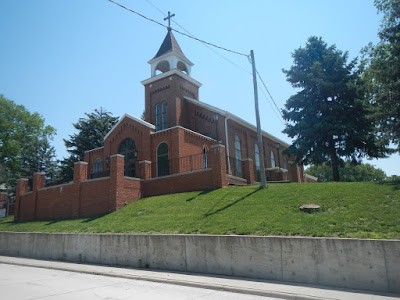On the
last morning before arriving at our grandson’s (and parent’s) home in Omaha, we
checked out a couple more sites that are listed on the National Register of
Historic Places…
As you
can see, this is the G.A.R. (Grand Army of the Republic) Memorial Hall and
Museum. It’s located at 901 1st
Corso in Nebraska City. This building
was built in 1894 in the Richardson Romanesque style. The
G.A.R., which was formed in 1866, was a nationwide movement composed of Union
veterans of the Civil War. (Comparable
to today’s American Legion, VFW, etc.) Aside
from the considerable political influence it wielded, the association worked to
increase patriotism and it provided an environment of fraternity and
comradeship for its members. This building is one of only three existing
free-standing halls that were built exclusively for the G.A.R. in Nebraska.
Factoid:
· The last surviving G.A.R. member that actually
saw combat in the Civil War died in 1953.
He was 109 years old. The last
surviving member of the G.A.R. died in 1956 at 109 years of age. He was a drummer boy who’s unit never saw
combat.
Unfortunately,
the G.A.R. Memorial Hall and Museum is only open on the weekends. The on-line photos of the exhibits look very
interesting and we will have to come back for a visit. To learn more, just go to http://www.civilwarmuseumnc.org/.
This is
St. Benedict's Catholic Church which is located at 411 5th Rue at
the summit of Kearney Hill in Nebraska City.
The rear portion of this Romanesque Revival style church was built in
1861 and it’s believed to be the oldest brick Catholic Church in Nebraska. The church bell came from the wreck of a
paddlewheel steamboat on the Missouri River.
Part of
the reason for this church’s listing on the Register is its association with Father
Emmanuel Hartig, a missionary and Benedictine priest. Father Hartig, who was a native of Germany,
served St. Benedict's for 40 years. (1861 – 1874 and 1881 – 1908) He was
responsible for the erection of 6 Catholic churches and the establishment of
several parishes in southeastern Nebraska and northwestern Missouri.
As a
tourist destination at its current location in Nebraska City since 1937, the
Mayhew Cabin and "John Brown's Cave" were a commercial enterprise
created by Edward Bartling. However its
importance to the state of Nebraska is more complex. With its connections to known abolitionist
John Henry Kagi and a location that facilitated easy access across the Missouri
River into Iowa, whether real or imagined, this property provided Nebraskans with
an easily accessible connection to significant symbols of American History,
such as John Brown and the Underground Railroad. With skepticism and intrigue surrounding the
property, the cabin and cave serve as a unique piece of Nebraska folklore.
The
Mayhew Cabin itself was built in 1855 by Allen Mayhew in 6 weeks. He used mostly cottonwood logs for the
construction, which he hewed and squared. Then the ‘chinking’ and ‘daubing’ were placed
in between the logs and a wood shingle roof was added to finish the construction.
To
learn more about this historic site, tourist attraction and museum, go to http://www.mayhewcabin.org/.
Next…North
to Plattsmouth Nebraska…
This is
the Captain John O’Rourke House at 424 North 6th Street in
Plattsmouth Nebraska. Constructed in
1881, this is a fine example of an Italianate house. The timing or popularity of building styles in
Nebraska do not fit neatly into nationwide architectural trends, with stylistic
trends tending to reach Nebraska approximately 10 years late and persisting
about a decade after they had fallen out of fashion nationally. Nebraska was only 13 years old in 1880. Settlers could rightly describe themselves as
a success if they just managed to eke a sufficient enough living to stay. Consequently, in those early years, the few
who were extremely successful might construct a substantially built and
designed house of such a recognizable style.
John O'Rourke
emigrated from Ireland and almost immediately joined the Union Army. He fought in the Civil War, was wounded, was
a prisoner of war, escaped several times and he achieved the rank of Captain by
the time he was mustered out of the army.
He is reputed to be the subject of the song or ballad “When Johnny Comes
Marching Home”. His brother-in-law,
Patrick S. Gilmore wrote the song… To learn more about Captain O’Rourke, just
go to http://inorourkesfootsteps.blogspot.com/.
Constructed
in 1896, the Paul Gering House is located at 423 North 6th Street in
Plattsmouth. The two-and-one-half-story
wood-frame structure was designed in the Colonial Revival style. Gering was a German emigrant who became an
obviously successful pharmacist. The
home cost $4,500 to build back in 1896…that would equal more than $500,000 in
today’s dollars. Interestingly, the
Gering family lived in the O’Rourke home across the street prior to moving into
their new house.
Plattsmouth
is located on the Missouri River just a little south of Omaha. It is the county seat for Cass County
Nebraska. Currently, this attractive
small city’s population is about 6,500.
Although the number of residents seems to have stabilized in recent
years, at its peak in 1890, the town counted about 8,400 citizens.
Factoid:
· Famous mystery/crime story author Raymond
Chandler is from Plattsmouth. His most
famous books include “The Big Sleep”, Farewell, My Lovely” and “The Long
Goodbye”.
That’s
all for now… Just click on any of the photos to enlarge them.
Thanks
for stopping by for yet another series of history snippets!
Take
Care, Big Daddy Dave





Love the little Mayhew Cabin and also the Gering House. It's hard to fathom that some Civil War veterans lived to 109. Wow.
ReplyDeleteSam